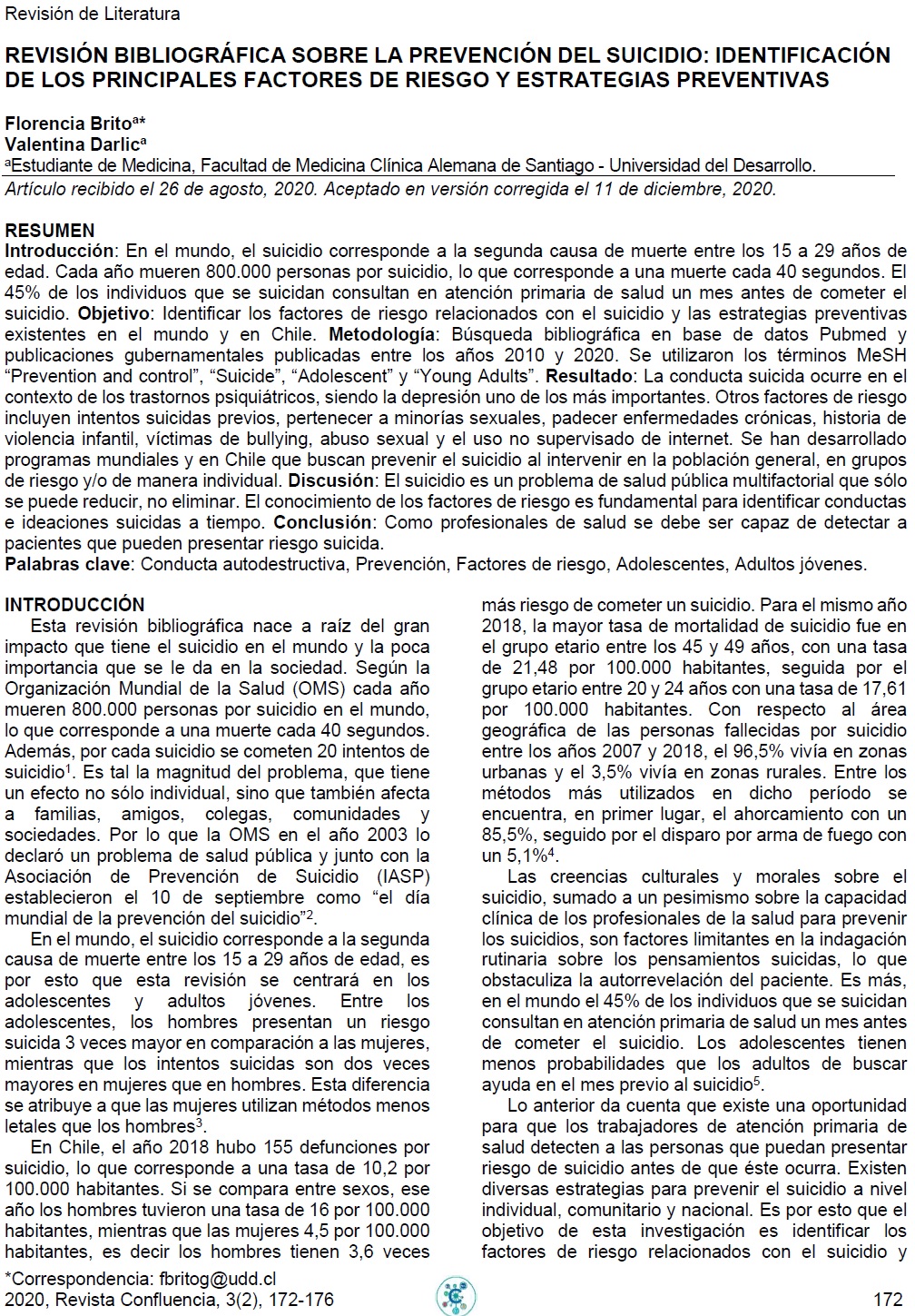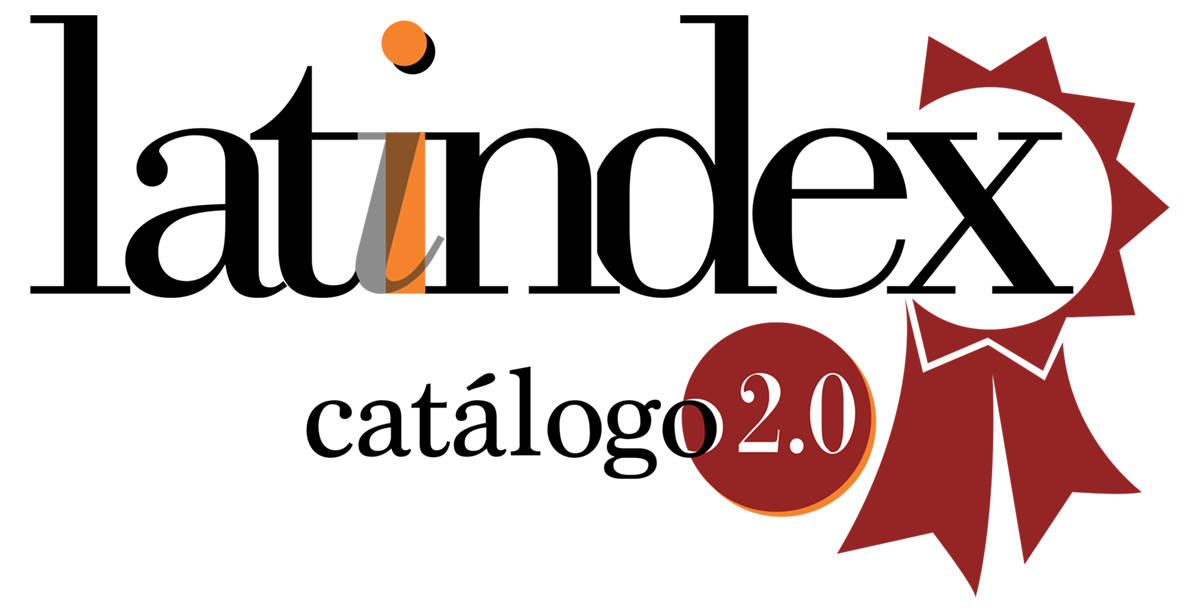Revisión bibliográfica sobre la prevención del suicidio, identificación de los principales factores de riesgo y estrategias preventivas
DOI:
https://doi.org/10.52611/confluencia.num2.2020.485Keywords:
Conducta autodestructiva, Prevención, Factores de riesgo, Adolescentes, Adultos jóvenesAbstract
Introducción: En el mundo, el suicidio corresponde a la segunda causa de muerte entre los 15 a 29 años de edad. Cada año mueren 800.000 personas por suicidio, lo que corresponde a una muerte cada 40 segundos. El 45% de los individuos que se suicidan consultan en atención primaria de salud un mes antes de cometer el suicidio. Objetivo: Identificar los factores de riesgo relacionados con el suicidio y las estrategias preventivas existentes en el mundo y en Chile. Metodología: Búsqueda bibliográfica en base de datos Pubmed y publicaciones gubernamentales publicadas entre los años 2010 y 2020. Se utilizaron los términos MeSH “Prevention and control”, “Suicide”, “Adolescent” y “Young Adults”. Resultado: La conducta suicida ocurre en el contexto de los trastornos psiquiátricos, siendo la depresión uno de los más importantes. Otros factores de riesgo incluyen intentos suicidas previos, pertenecer a minorías sexuales, padecer enfermedades crónicas, historia de violencia infantil, víctimas de bullying, abuso sexual y el uso no supervisado de internet. Se han desarrollado programas mundiales y en Chile que buscan prevenir el suicidio al intervenir en la población general, en grupos de riesgo y/o de manera individual. Discusión: El suicidio es un problema de salud pública multifactorial que sólo se puede reducir, no eliminar. El conocimiento de los factores de riesgo es fundamental para identificar conductas e ideaciones suicidas a tiempo. Conclusión: Como profesionales de salud se debe ser capaz de detectar a pacientes que pueden presentar riesgo suicida.
Downloads
References
World Health Organization. Suicide [Internet]. Ginebra: WHO; 2019 [citado el 9 de agosto de 2020]. Disponible en: https://www.who.int/health-topics/suicide#tab=tab_1
Wong JC. Predicting Suicide and its Prevention. Ann Acad Med Singapore. 2018;47(9):357-9.
Shain B; Committee on adolescence. Suicide and Suicide Attempts in Adolescents. Pediatrics. 2016;138(1):e20161420. doi: 10.1542/peds.2016-1420.
Servicio de Salud Metropolitano Sur Oriente. Defunciones y Mortalidad observada por Lesiones Autoinfligidas Intencionalmente [Internet]. Santiago: Departamento de Control de Gestión del Ministerio de Salud de Chile; 2019 [citado el 9 de agosto de 2020] Disponible en: http://estadistica.ssmso.cl/downloads/informe_de_suicidio/suicidios-2007-2018.pdf
Turecki G, Brent DA. Suicide and suicidal behaviour. Lancet. 2016;387(10024):1227-39. doi: 10.1016/S0140-6736(15)00234-2.
Hegerl U. Prevention of suicidal behavior. Dialogues Clin Neurosci. 2016;18(2):183-90.
Zalar B, Kores Plesničar B, Zalar I, Mertik M. Suicide and Suicide Attempt Descriptors by Multimethod Approach. Psychiatr Danub. 2018;30(3):317-22. doi: 10.24869/psyd.2018.317.
Large MM. The role of prediction in suicide prevention. Dialogues Clin Neurosci. 2018;20(3):197-205. doi: 10.31887/DCNS.2018.20.3/mlarge.
King CA, Arango A, Ewell Foster C. Emerging trends in adolescent suicide prevention research. Curr Opin Psychol. 2018;22:89-94. doi: 10.1016/j.copsyc.2017.08.037.
Messias E, Castro J, Saini A, Usman M, Peeples D. Sadness, suicide, and their association with video game and internet overuse among teens: results from the youth risk behavior survey 2007 and 2009. Suicide Life Threat Behav. 2011;41(3):307-15.
Tomicic A, Gálvez C, Quiroz C, Martínez C, Fontbona J, Rodríguez J, et al. Suicidio en poblaciones lesbiana, gay, bisexual y trans: revisión sistemática de una década de investigación (2004-2014). Rev Med Chil. 2016;144(6):723-33.
Katsumata Y, Matsumoto T, Kitani M, Takeshima T. Electronic media use and suicidal ideation in Japanese adolescents. Psychiatry Clin Neurosci. 2008;62(6):744-46.
Hagihara A, Miyazaki S, Abe T. Internet suicide searches and the incidence of suicide in young people in Japan. Eur Arch Psychiatry Clin Neurosci. 2012;262(1):39-46.
Durkee T, Hadlaczky G, Westerlund M, Carli V. Internet pathways in suicidality: a review of the evidence. Int J Environ Res Public Health. 2011;8(10):3938-52.
Kreitman N. The coal gas story. United Kingdom suicide rates, 1960-71. Br J Prev Soc Med. 1976;30(2):86-93.
Large MM., Nielssen OB. Suicide in Australia: meta-analysis of rates and methods of suicide between 1988 and 2007. Med J Aust. 2010;192(8):432-7.
Gunnell D, Knipe D, Chang SS, Pearson M, Konradsen F, Lee W, et al. Prevention of suicide with regulations aimed at restricting access to highly hazardous pesticides: a systematic review of the international evidence. Lancet Glob Health. 2017;5(10):e1026-37.
Hawton K, Bergen H, Simkin S, Dood S, Pocock P, Bernal W, et al. Long term effect of reduced pack sizes of paracetamol on poisoning deaths and liver transplant activity in England and Wales: interrupted time series analyses. BMJ. 2013;346:f403.]
Law CK., Sveticic J., De Leo D. Restricting access to a suicide hotspot does not shift the problem to another location. An experiment of two river bridges in Brisbane, Australia. Aust N Z J Public Health. 2014;38(2):134-8.
Kerr WC, Subbaraman M, Ye Y. Per capita alcohol consumption and suicide mortality in a panel of US states from 1950 to 2002. Drug Alcohol Rev. 2011;30(5):473-80.
Tondo L, Albert MJ, Baldessarini RJ. Suicide rates in relation to health care access in the United States: an ecological study. J Clin Psychiatry. 2006;67(4):517-23.
Schomerus G, Evans-Lacko S, Rusch N, Mojtabai R, Angermeyer MC, Thornicroft G. Collective levels of stigma and national suicide rates in 25 European countries. Epidemiol Psychiatr Sci. 2015;24(2):166-71.
Fountoulakis KN, Kawohl W, Theodorakis PN, Kerkhof AJ, Navickas A, Höschl C, et al. Relationship of suicide rates to economic variables in Europe: 2000-2011. Br J Psychiatry. 2014;205(6):486-96.
Callaghan S, Ryan C, Kerridge I. Risk of suicide is insufficient warrant for coercive treatment for mental illness. Int J Law Psychiatry. 2013c;36(5-6):374-85.
Reider EE, Sims BE. Family-based preventive interventions: Can the onset of suicidal ideation and behavior be prevented? Suicide and Life-Threatening Behavior. 2016;46(Supplemental 1):S3-S7.
Rheingold AA, Zajac K, Chapman JE, Patton M, de Arellano M, Saunders B, et al. Child sexual abuse prevention training for childcare professionals: An independent multi-site randomized controlled trial of stewards of children. Prevention Science. 2015;16(3):374-85.
Walsh K, Zwi K, Woolfenden S, Shlonsky A. School-based education programs for the prevention of child sexual abuse. Res Soc Work Pract. 2015:1-23.
World Health Organization. Preventing Suicide: a Global Imperative. Geneva, Switzerland: WHO; 2014.
Ministerio de Salud, Chile. Programa Nacional de Prevención del Suicidio: orientaciones para su implementación [Internet]. Santiago: Departamento de Salud Mental, Subsecretaría de Salud Pública; 2013 [citado el 9 agosto de 2020]. Disponible en: https://www.minsal.cl/sites/default/files/Programa_Nacional_Prevencion.pdf

Downloads
Published
How to Cite
Issue
Section
License
Copyright (c) 2020 Revista Confluencia

This work is licensed under a Creative Commons Attribution-NonCommercial-NoDerivatives 4.0 International License.







